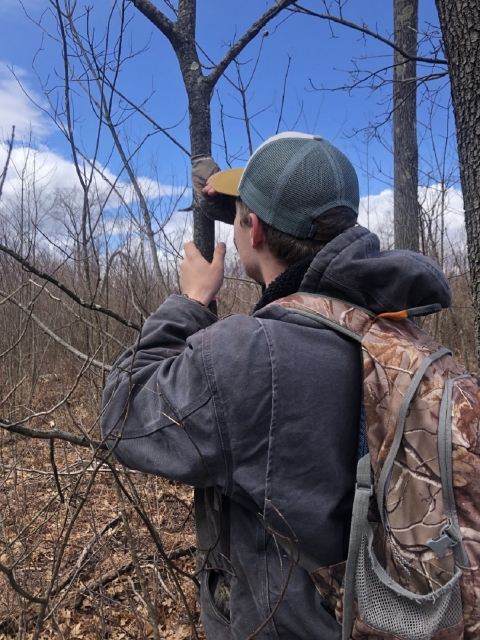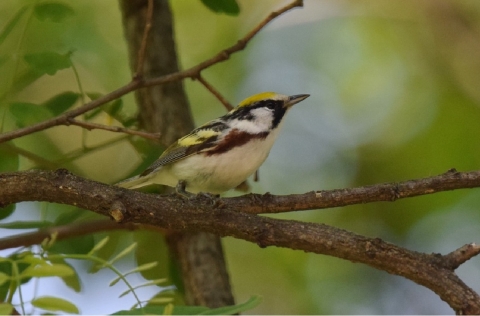If a cerulean warbler sings in a forest, and nobody is around to hear it, does it make a sound?
Thanks to a collaborative effort led by the American Bird Conservancy, the Indiana University of Pennsylvania, and the University of Pittsburgh to deploy hundreds of audio recording units in Pennsylvania forests, we know the answer is yes.
But that’s not the question the researchers are trying to answer.
“Our goal is to manage these forests to create healthy, structurally diverse habitats that meet the needs of both at-risk and common bird species,” explained Jeffery Larkin, the Eastern Forest Bird Habitat Coordinator for the American Bird Conservancy and a professor at Indiana University of Pennsylvania. “Audio monitoring helps us figure out if it’s working.”
The project, funded by the National Fish and Wildlife Foundation’s Central Appalachian Habitat Stewardship Program, which is supported by the U.S. Fish and Wildlife Service and other partners, focuses on forested areas where two priorities overlap.
The first is populations of bird species whose numbers are declining , but could rebound with intervention— like cerulean warbler, golden-winged warbler, and wood thrush. The second is strong partnerships with stakeholders who support conservation, including state and federal agencies, nongovernmental organizations, and private landowners.
Within these areas, the partners work together to carry out a continuous cycle of forest-stewardship planning and action to support these species.
That brings us back to question the researchers are trying to answer. It’s more like: if we manage a forest with the needs of cerulean warbler in mind, will they use it?
A game changer
It’s not a new question, but autonomous recording units — ARUs for short — are giving scientists significantly more detailed answers, much more efficiently. It’s like the difference between a stopwatch and a fitness tracker as a training tool for a competitive runner. A game changer.
Larkin pointed to American woodcock as an example, explaining that there’s about a 20-day window, from mid-April to early May when you are able to survey singing woodcock in the Central Appalachians. But only during a 38-minute period shortly following sunset. And that’s just on evenings when it’s not rainy, windy, or cold, which can be few and far between in early spring.
“Think about trying to do that with humans. You have just 20 days to visit all of the monitoring sites — 140 in this case — for 38 minutes a night, which requires getting in and out of slash-ridden forests in the dark,” Larkin said. “There’s no way you could do repeat sampling at multiple sites in a single season that way.”
Now picture the alternative: Calmly driving from site to site in the daytime and attaching ARUs pre-programmed to record at a certain time of day to trees, weeks before you expect woodcock to arrive. “You can get them all out in a couple of days, and then relax, knowing you will be able to come back and recover the vast majority, with maybe a few lost to weather or bears,” he said.
And instead of data from single 38-minute visits to however many sites you can get to during the 20-day monitoring period, you have daily 38-minute recordings from 140 sites over the entire period.
Sound approach
Acoustic monitoring has been used to study wildlife for decades — beginning largely with marine mammals and bats — but the use of this technology has been expanding in part due to declining costs.
A few years ago, the most widely available ARU for wildlife surveying cost about $800 per device. Not something you could reasonably deploy by the hundreds in the woods of central Pennsylvania.
The devices Larkin is using for monitoring, however, only cost about $75, including the batteries, SD memory cards, and other extra materials needed to strap them to trees. They’re also open source, meaning the specs for how to make them are freely available online.
But the ability to use audio to monitor more species in more places is only as useful as your ability to process the resulting data. That’s why advances in data extraction have been key to wider adoption.
“Imagine you’ve recorded tens of thousands of hours in the forest, and you’re looking for a cerulean warbler or a golden-winged warbler,” said Justin Kitzes, an assistant professor of biological sciences at the University of Pittsburgh. “How in the world are you going to find it? Because you’re not going to listen to all of those recordings.”
In case you’re wondering if you could, 10,000 hours is about 14 months. Tens of thousands is significantly longer.
That’s where the Kitzes Lab comes in.
“People have been trying to solve this kind of problem for a long time, and now with methods centered on neural networks, we can effectively pull out songs of these focal species from these enormous sets of recordings,” Kitzes said.
If you use speech recognition on your smartphone, you benefit from neural networks. An approach to artificial intelligence, it’s essentially a way to train a computer model to perform a task.
Previously, if you wanted to train a model to identify the call of a cerulean warbler, you might provide it with a kind of identification key: the song of a cerulean warbler has three parts, in these pitches, and they play in a certain order, for a certain length of time.
“You would describe what all the characteristics are supposed to be, and then you would tell the model to look for those characteristics,” Kitzes said.
With neural networks, instead of telling the model what characteristics to look for, you provide examples for the model to learn from.
“We give it both positive examples, and negative examples — this is a cerulean warbler, this is not — maybe a few hundred of each,” he explained. “Then you say, now I want you to figure out how to predict if a file does or does not have a cerulean warbler song in it.”
They don’t train the model with sound, but with pictures of sound, called spectrograms.
If you’ve used an audio recorder app on your phone, you’ve seen one depiction of sound — a waveform showing the peaks and valleys of volume changing over time. A spectrogram has another dimension — a vertical dimension — that separates out the different frequencies, or pitch, of sound. The darkness of the color in the image tells you how loud each pitch was at a particular time.
With support from National Geographic and Microsoft, Kitzes has already used this approach to train 500 models — called classifiers — to identify 500 temperate bird species.
But to support this project, in which the focal bird species are both driving specific management actions, and helping to measure how effective they are, Kitzes’ team is fine tuning the models even more.
“We’re going to get specific examples from the Central Appalachians region that we can use to train a better model that really understands what the world sounds like here, so we’ll be better able to identify these birds in this particular landscape,” he said.
Their goal is to put out 500 new recorders this year, which they expect to collect 80 thousand hours of recording
They’ll then cut those 80 thousand hours into five-second clips — about 100 million — and feed those into the model, which will give them a score that says, this is how confident I feel that this is or is not a cerulean warbler.
Then you rank the clips, from most likely to contain a cerulean warbler to least likely to contain one, and find experienced birders to listen to high-scoring files — 10 or 15 clips — to confirm the identification.
“If the models do well, and in our experience they do, you’re probably going to hear the bird in the first five minutes of listening if it was there, because the model would have found the best, clearest examples,” he said.
Sense of place
In addition to convenience, the ARUs offer perspective. More than just a point in time at a specific site, they provide an audio portrait — a sense of place.
“When you bring this data back, you get a permanent record of the biodiversity of that landscape that year,” Kitzes said.
It gives researchers a way to answer the questions they need to — cerulean warblers: present — and an opportunity to explore new ones. Larkin pointed to a recent project led by one of his graduate students, Halie Parker, comparing breeding season use of fenced (to exclude deer) and unfenced timber harvests by chestnut-sided warblers.
Parker deployed a number of ARUs in fenced and unfenced timber harvest area in the Central Appalachians before chestnut-sided warblers returned in April, and was able to document their exact date of arrival, and the daily occupancy rate for each survey point in the fenced and unfenced areas.
At points in the fenced harvests, chestnut-sided warbler occupancy was nearly 90 percent throughout the entire territory settlement and breeding season. In the unfenced areas, occupancy was around 50 percent during the territory settlement phase, but increased to a rate similar to fenced harvests during the breeding season.
Larkin said human observers would have only monitored these sites a couple of times, and only during the breeding season, so the conclusion would have been that chestnut-sided warbler occupancy was similar between fenced and unfenced harvests.
But the ARUs told the whole story. Because they were at the sites from April through late May, and programmed to record every morning, they revealed that upon arrival from their wintering grounds, male chestnut-side warblers overwhelmingly sought to establish territories in fenced harvests.
“It illustrated that when those birds arrived, it was game on for establishing a territory in those fenced harvests. Everyone wanted to be inside,” Larkin said. “But there’s a point where the losers have to go somewhere else.”
Where did they go? To the unfenced harvest.
“There really was a battle among males to be in those fenced harvests, and that gives us a sense of what quality habitat means to these birds,” he said. “How would Halie have captured that otherwise?”
You probably know the answer.
The effort to conserve at-risk wildlife and recover listed species is led by the Service and state wildlife agencies in partnership with other government agencies, private landowners, conservation groups, tribes, businesses, utilities, and others. It has drawn support for its use of incentives and flexibilities within the Endangered Species Act to protect rare wildlife, reduce regulations, and keep working lands working.










